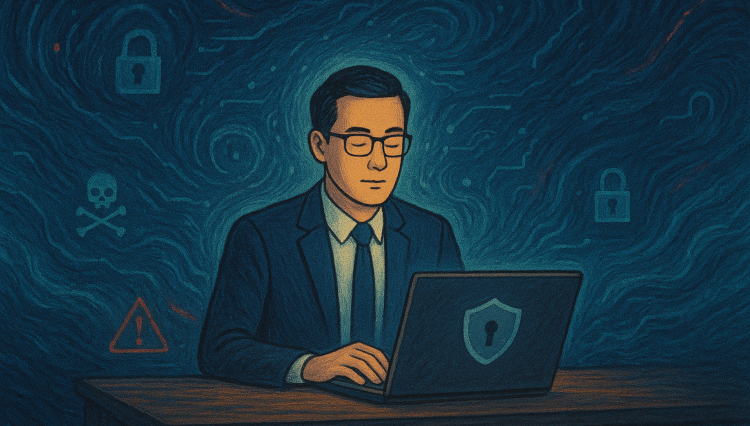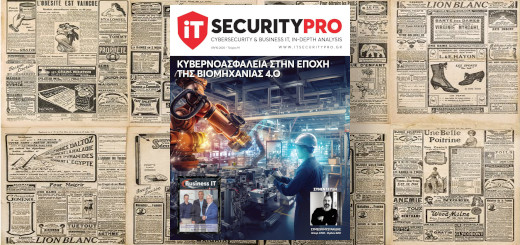The Calm Inside the Cyberstorm

How Modern CISOs Stay Always On Without Burning Out
The 4:00 A.M. Hour
At 4:00 a.m., the world is still. Outside, the city hasn’t yet woken; the air feels heavy, pre-dawn quiet. But for a Chief Information Security Officer, the day has already begun. The screen glows softly in the dark, dashboards humming with silent urgency – alerts, risk scores, a pulse of global activity that never truly stops. Another day for CISO Leadership and Burnout Management has begun.
There’s no pause button in this job. Threats don’t clock out. Risk doesn’t rest during weekends. And one small oversight – one click, one unpatched system – can undo months of progress. That’s the asymmetry every CISO lives with; the adversary only needs to be right once. You have to be right every single time.
For some, that pressure would be unbearable. But for others, it becomes fuel. Over time, the stress mutates into a kind of steady awareness—an inner current of vigilance that hums quietly beneath everything. You stop flinching at the noise and start listening for the signal. The fear turns into focus. And that focus, properly honed, becomes the edge that keeps you standing when others fall.
It’s not paranoia. It’s pattern recognition. And when mastered, it becomes a source of power.
A Life Built on Routine
The rhythm of a CISO’s life looks extreme from the outside. The day begins before dawn, long before messages start flooding in. Coffee brews, workouts happen, notes are written, priorities are set. Every hour has a purpose, and every block of time is intentional.
That discipline isn’t just habit – it’s armor. In a world defined by unpredictability, structure becomes the only real control you have. The calendar isn’t a cage; it’s a shield.
There’s a saying that discipline equals freedom, but for security leaders, it’s deeper than that. Discipline is identity. It’s what keeps the day from dissolving into noise. When you know who you are and how you operate, you stop negotiating with feelings. There’s no internal debate about motivation or comfort. You just move.
What looks like rigidity from the outside is actually peace. Structure gives flexibility. Order allows reaction. Routines – those seemingly mundane rituals – are what keep the chaos from taking hold.
Clarity Begins Offline
Cybersecurity leaders are trained to monitor networks 24/7. Yet the most important system they protect is themselves.
The irony of leading in a hyperconnected world is that the most critical work happens offline. The job demands clarity, and clarity doesn’t coexist with exhaustion.
That’s why many security leaders treat rest, recovery, and reflection as part of their operational strategy. Good sleep isn’t optional; it’s tracked, protected, and defended. The morning often starts in silence—no screens, no news, no pings. Just space to think, to breathe, to prepare.
It wasn’t always this way. There was a time when exhaustion was worn like a badge of honor—when 18-hour days and “powering through” fatigue were considered signs of commitment. But experience teaches that tired minds make careless choices.
The burnt-out CISO isn’t brave; they’re dangerous. When fatigue sets in, judgment slips. Reaction replaces strategy. The very thing you’re sworn to protect—stability—begins to erode from within.
So, recovery becomes as serious as readiness. The run, the meditation, the disconnection—they aren’t wellness gestures. They’re part of the defense system.
The Power of Radical Presence
Cybersecurity runs on speed – fast threats, fast responses, fast thinking. The faster you detect, the faster you respond, the safer you stay. Yet, paradoxically, the leaders who excel at it learn to slow down.
Speed alone doesn’t win; presence does.
To be present in this role means giving full attention to whatever – or whoever – is in front of you, even when your inbox is exploding and a dozen fires are waiting. It’s knowing that during an incident, the calmest person in the room will anchor everyone else.
That kind of presence isn’t natural. It’s trained. It comes from deliberate practice – moments of silence, mindfulness, journaling, breath work. Learning to notice when your focus drifts and to bring it gently back. It’s not spiritual posturing; it’s operational readiness.
Because when chaos erupts – and it always does – the calmest person in the room dictates the outcome. The ability to stay grounded when everyone else panics is what separates leadership from reaction.
At first, the stillness feels uncomfortable. The mind rebels. But over time, it becomes the center of gravity – the calm eye of the cyberstorm.
A CISO’s real advantage isn’t knowledge or authority; it’s composure. In the middle of chaos, when others rush to react, the one who can pause and see clearly has already won half the battle.
Presence, more than power, keeps the ship steady.
The Art Behind the Science
It’s easy to think of cybersecurity as a science – frameworks, protocols, compliance checklists. But at the highest level, it’s also an art form. Attackers are creative by nature. They experiment, adapt, and invent new ways to exploit systems. To defend against creativity, defenders must be creative too. Defenders, must be artist.
That realization often changes how experienced CISOs see their craft. They stop viewing rules as constraints and start seeing them as raw materials. Frameworks, like ingredients in a recipe, are meant to be adapted. The artistry lies in knowing how to blend them, how to season them for the specific culture and risk appetite of your organization.
One CISO tells a story about asking a Parisian chef to make his favorite dish, not the special on the menu. What arrived wasn’t a standard plate – it was something personal, crafted with pride. That memory became a metaphor: compliance done right isn’t about ticking boxes. It’s about creating something effective, tailored, and alive.
The best leaders approach cybersecurity with that same creative sensibility. They don’t just defend; they design.
The Loneliness of Perspective
Every CISO sits at a crossroads few others see. One moment you’re in a boardroom translating threat models into business risk. The next, you’re deep in architecture reviews, or advising on privacy for a new product, or joining a late-night call with IT to manage a live incident.
It’s a role that touches everything and yet belongs to no single domain. Technology, law, business, psychology – all converge here. You’re never alone, yet in one important way, you often stand apart.
The isolation doesn’t come from people; it comes from perspective. No one else carries the same 360-degree view – the awareness of how a single vulnerability can ripple across departments, markets, and reputations. That vantage point changes how you communicate. That breadth creates both clarity and isolation. It’s why so many CISOs spend as much time studying communication as they do studying code.
Over time, the most effective CISOs learn that cybersecurity is not just technical – it’s profoundly human. Almost every major incident begins with human behavior: a click, a misjudgment, a shortcut. So they focus less on jargon and more on understanding why people make the choices they do.
Instead of calling humans the weakest link, they see them as the strongest potential defense – if engaged the right way.
Owning the Message
Communication defines leadership in this field. A CISO who can’t connect the dots for others—especially at the executive level – loses more than just influence; they lose alignment.
One story captures this truth perfectly. After a polished board presentation, a CISO walked away uneasy. The data had landed, but the message hadn’t. So they turned around, walked back into the room, and said simply, “If something didn’t click, that’s on me. Tell me where I lost you.”
That vulnerability changed everything. The polite silence broke. Real dialogue began. The board members admitted what hadn’t made sense. The conversation turned from formality to understanding.
The following week, the CEO called to talk about next steps.
Moments like that redefine what leadership looks like in cybersecurity. It’s not about fear or authority; it’s about clarity and accountability. When people don’t understand, it’s not their failure to listen—it’s your failure to translate.
The Infinite Student
Cybersecurity is a field that punishes arrogance. The moment you think you’ve mastered it, you’re already outdated.
The best CISOs never stop learning. They
- study constantly – new frameworks, new attack patterns, new disciplines entirely
- learn from junior analysts and interns, because fresh eyes often see what experts miss
- read beyond the field—philosophy, psychology, geopolitics—because everything connects
Curiosity keeps them humble, and humility keeps them adaptable. They know that expertise in this domain isn’t a destination; it’s a moving target.
There’s no final version of yourself in this work. The goal is simply to be sharper tomorrow than you were today—and to help your team do the same.
Extreme Ownership, Real Trust
Leadership in cybersecurity demands a paradox: own everything, but control nothing. Leadership in cybersecurity carries a unique burden. Even when you didn’t write the code, approve the change, or click the link, you still feel responsible for the outcome. That’s part of the job.
True leaders embrace that. They practice what’s often called “extreme ownership” – taking full responsibility for outcomes, not just actions. If something fails, they fix the process that allowed it. They don’t blame; they build.
But ownership doesn’t mean doing everything yourself. The modern CISO learns that you can’t scale leadership through control; you scale it through trust. Delegation becomes an act of empowerment. Tasks are handed off with clarity, but without micromanagement. Team members are encouraged to think, decide, and lead.
When something goes wrong, it’s treated as a shared lesson, not a personal failure. Over time, this creates something powerful: more leaders. The proudest moments often come quietly – when someone you’ve mentored makes a hard decision alone and gets it right. That’s when you realize success isn’t measured by how much you control, but by how unnecessary you’ve become.
Choosing the Storm
The life of a modern CISO isn’t one to stumble into. It has to be chosen – deliberately, consciously, and with full awareness of its cost. It’s a lifestyle of structure, focus, recovery, and trust. A way of transforming relentless pressure into purposeful energy.
The “always on” nature of the job is real, but chaos doesn’t have to be. Structure, clarity, rest, and trust transform what could be an exhausting profession into a sustainable one. How security leaders live – how they think, how they recover, how they show up – will shape the future of the industry.
Because in the end, cybersecurity isn’t about fighting the storm.
It’s about becoming the calm inside it.



